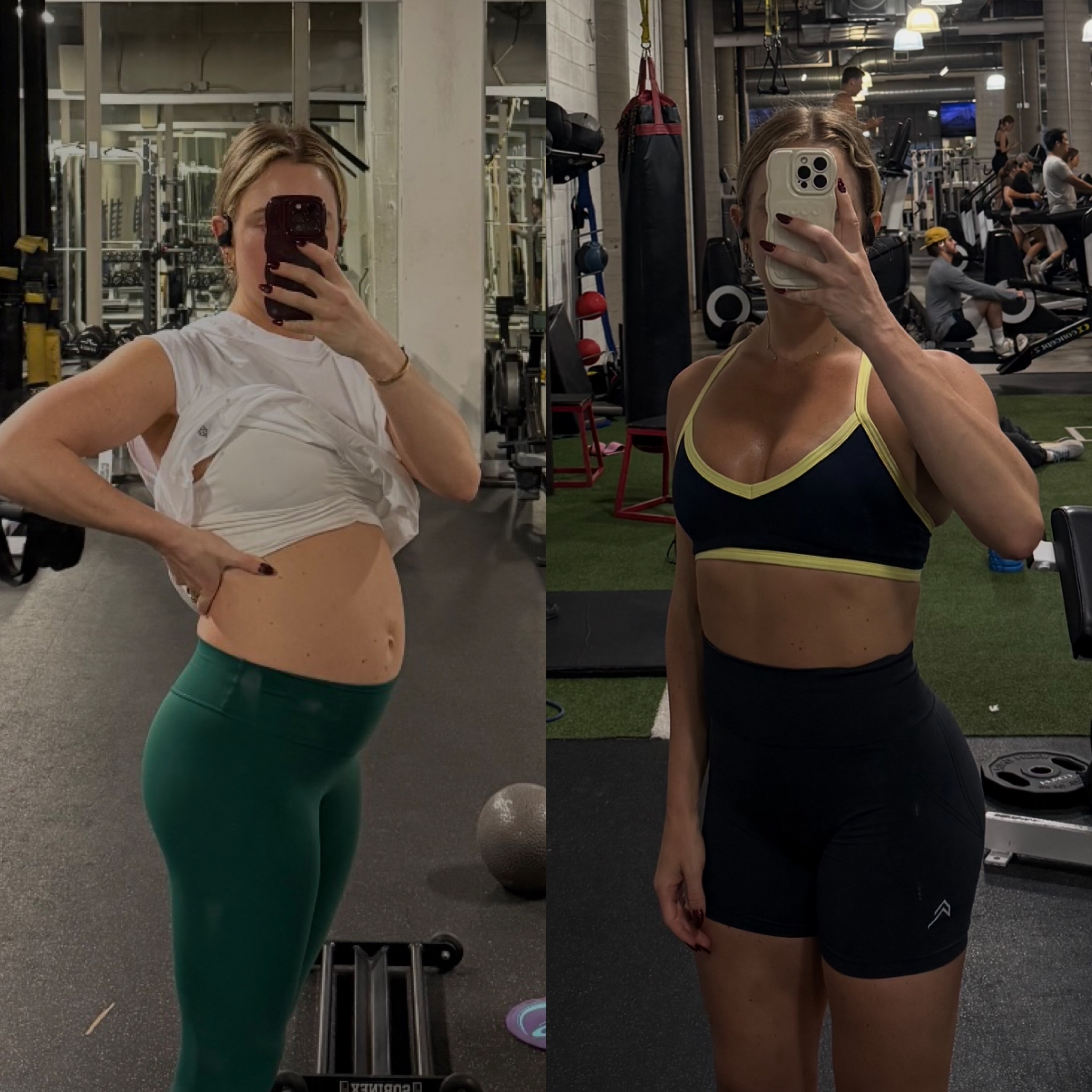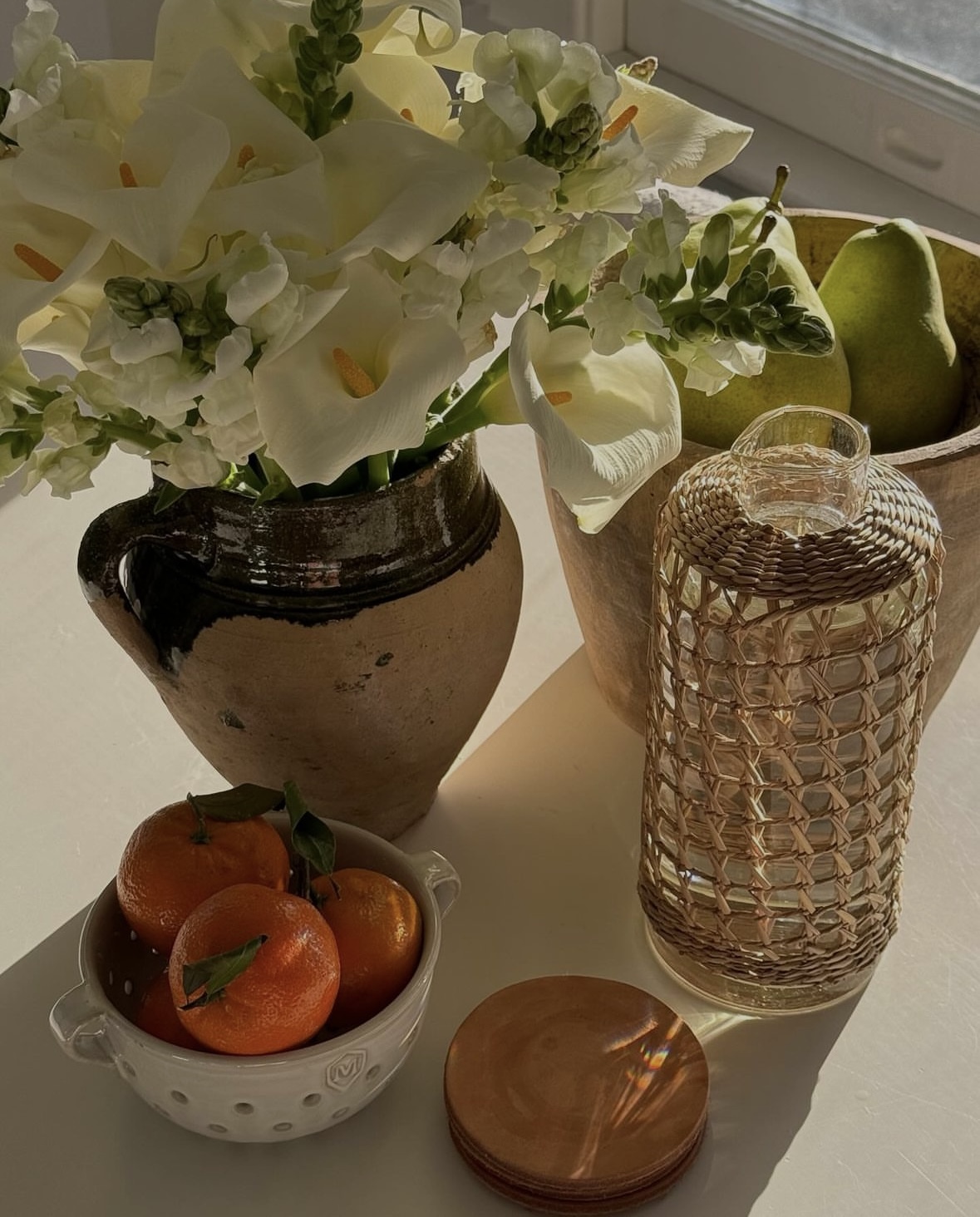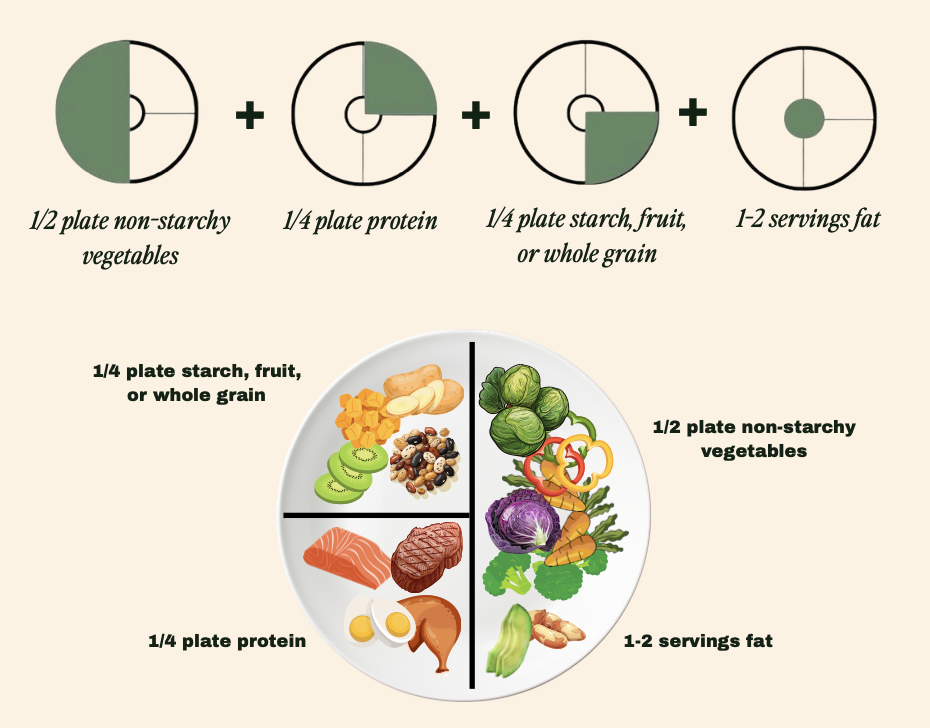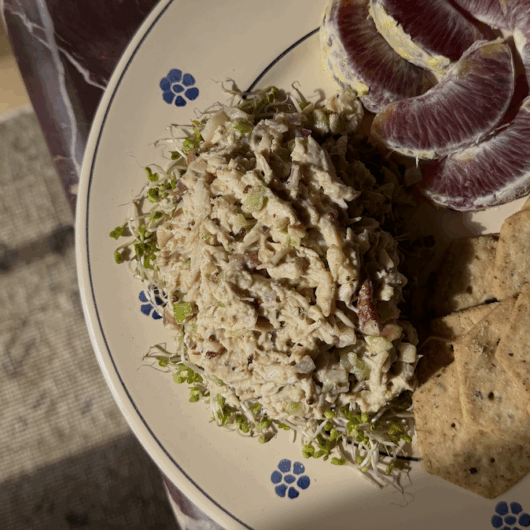Find your answers | Heal naturally | Reclaim true wellness | Find your answers | Heal naturally | Reclaim true wellness | Find your answers | Heal naturally | Reclaim true wellness
Functional Nutrition Solutions
for Women
Helping women heal their hormones, overcome digestive issues, recover their metabolism, and experience life at its fullest potential.
Find your answers | Heal naturally | Reclaim true wellness | Find your answers | Heal naturally | Reclaim true wellness | Find your answers | Heal naturally | Reclaim true wellness
Have you been struggling with frustrating health symptoms like
chronic low energy, gut issues, weight fluctuations, acne,
period problems, or anxiety?
Are you confused by the endless cycle of online scrolling and researching symptoms trying to figure it out on your own?
Are you exhausted from working overtime on your health and trying to do it all perfectly without seeing real results?
I get it because I was you.
It’s time for a change.
I help women identify and address the unique root cause of their hormone and digestive symptoms with clear answers and a roadmap to sustainable, optimal health.
By partnering together, you’ll learn exactly how to nourish, move, and support your body so that you are no longer weighed down by the symptoms and doubt that have been getting in the way of living the life you are meant to.
Find your answers | Heal naturally | Reclaim true wellness | Find your answers | Heal naturally | Reclaim true wellness | Find your answers | Heal naturally | Reclaim true wellness
Find your answers | Heal naturally | Reclaim true wellness | Find your answers | Heal naturally | Reclaim true wellness | Find your answers | Heal naturally | Reclaim true wellness
Treat and heal symptoms,
Reverse your condition,
and Get back to feeling like yourself.
I take a whole-body approach to
Why Truly Well Works
Truly Well is the holistic, results-driven approach you’ve been looking for.
If you've had your symptoms dismissed by providers,
told there’s nothing you can do, or that your labs are “normal” despite feeling off, you’re in the right place.
If you’ve been given birth control or medication as the only solution,
but you know there has to be a better way, I'm here to uncover the root cause.
If you’re tired of guessing what’s wrong and cycling through diet trends,
I use functional testing to give you clear, science-backed answers.
If making lifestyle changes feels overwhelming,
I create a step-by-step, approachable plan that fits into your real life.
If you want to feel heard, supported, and empowered in your healing,
you deserve a compassionate partner in your health journey—I’ll be there every step of the way.
the SERVICES
My comprehensive 1:1 functional nutrition program helps you identify and address the root cause of your digestion, energy, skin, and inflammation challenges.

One of my favorite proteins for meal prep just got a Fall upgrade.

Feeling a little bloated here and there is totally normal. It can happen after a busy week, a weekend of eating out or a stressful day. But if you find yourself feeling bloated regularly, especially after meals or by the end of the day, that’s your body waving a flag that something deeper may be going on.
What most people don’t realize is that gut healing doesn’t start with supplements. It starts with your nervous system. One of the most overlooked pieces of digestion is the connection between stress, circadian rhythm, and gut health. There are simple, science-backed strategies you can start today to begin shifting out of a stress response that will reduce bloating and support better digestion.
1. Focus On How You Are Eating
Most people only focus on what they eat, but how you eat matters just as much. Your digestive system can’t do its job properly if you’re rushing, stressed, or barely chewing your food. When we slow down, and help the body feel safe, digestion becomes dramatically easier.
- Eat without distractions and pause between bites.
- We live in a go-go-go world, and meals are often squeezed between emails, errands, or scrolling. The problem? Eating in a stressed or distracted state shuts down digestion. When you’re in a “fight-or-flight” state, your body isn’t prioritizing breaking down food…it’s trying to survive. Stress hormones like cortisol and adrenaline reduce stomach acid and digestive enzymes and tense the muscles of your gut, which leads to… you guessed it: bloat. You’ll be amazed at how much better your body responds when meals aren’t treated like a race.
- The simple (but challenging!) fix:
- Pause, sit down, and take a moment before you begin
- Put your phone away and turn off screens
- Actually taste and enjoy your food
- Set your fork down between bites
- Chew thoroughly
- Digestion starts in the mouth, not the stomach. Chewing signals your brain to release stomach acid and enzymes while physically breaking down food so your gut isn’t stuck doing all the heavy lifting. Your stomach doesn’t have teeth! If you don’t chew well, bloating is inevitable.
- Aim to chew each bite 20-30 times, or until it’s the texture of applesauce
- Try diaphragmatic breathing before meals
- Deep, intentional breathing is one of the fastest ways to activate your “rest and digest” system. It relaxes your gut, improves motility, and primes your body for digestion.
- Try this before meals:
- Sit down with good posture
- Inhale for 4 seconds
- Hold for 4
- Exhale for 4
- Hold for 4
- Repeat 3-5 rounds
- Just 30 seconds of breathwork can radically improve how your body handles a meal.
2. Poop Daily
Let’s be honest. Regular bowel movements are non-negotiable for a bloat-free belly. If you’ve ever been told that going every couple of days is “normal,” I’m here to lovingly challenge that. It may be common, but it’s definitely not optimal.
Pooping is how your body eliminates waste and toxins. When you don’t go daily, stool sits in the colon, ferments, and creates gas—hello, bloating.
Simple ways to start supporting daily elimination:
- Increase potassium-rich foods (sweet potato, coconut water, avocado, beets)
- Eat 2–3 kiwis daily (research-backed for constipation relief)
- Sip mineral-rich drinks (electrolyte powders or adrenal cocktails)
- Add ground flax or chia seeds for fiber (start slow)
- Create a morning bowel routine: warm lemon water + breakfast + time to go
3. Align Meal Timing With Your Circadian Rhythm
Your gut runs on a rhythm just like your hormones and sleep cycle do. Digestion isn’t random — it follows your body clock. Microbes, digestive juices, and hormones all follow circadian rhythms. Going long stretches without eating, skipping meals, or snacking at odd hours can throw off your digestive rhythm and contribute to bloating.
To support your gut’s natural flow:
- Morning sunlight
- Aim to eat every 3–4 hours
- Start your day with a protein-rich breakfast within 1–2 hours of waking.
- Finish your last meal 2-3 hours before bedtime
Consistent meal timing keeps your digestive system regulated, stabilizes blood sugar, and reduces the chances of bloating later in the day.
4. Take a Gentle Walk After Meals
One of the simplest bloat hacks? Move your body after you eat. A slow 10–15 minute walk after meals stimulates lymph flow and peristalsis — the natural wave-like motion that moves food through your digestive tract. This keeps things moving (literally), helps prevent gas from building up, and even improves blood sugar balance. No need for a full workout…think “light stroll,” not sweat session. Your gut loves movement.
5. Avoid Grazing
Many people believe smaller, frequent meals and/or snacking is easier on digestion, but it actually does the opposite. Grazing all day keeps your digestive system constantly “on,” which shuts down a critical process called the Migrating Motor Complex (MMC).
The MMC acts like your gut’s housekeeping crew — it sweeps leftover food and bacteria out of the small intestine between meals. If you’re constantly nibbling, that cleanup never happens, food ferments, and bloating follows.
What to do instead:
- Leave 3–5 hours between meals and aim for 12 hours overnight (example: finish dinner by 8pm, eat breakfast at 8am).
- Build balanced, satisfying meals with protein, healthy fat, fiber, and carbs to keep you full and energized.
- If you’re hungry between meals, eat a real balanced snack (protein + fat + fiber + starch), not handful grazing
6. Try Digestive Bitters
Bloating is often a sign that your digestion needs a little wake-up call. Bitter foods and herbs naturally stimulate stomach acid and digestive enzyme production, helping your body break down food more efficiently.
Try incorporating digestive bitters 5–10 minutes before meals. You can use a tincture (I love Urban Moonshine or Herb Pharm), or get bitters naturally from foods like:
- Apple cider vinegar
- Fennel seeds
- Dandelion greens
- Lemon water
- Ginger
Bitters are especially helpful when eating out or during travel when bloating tends to show up more often.
Final Thoughts + Next Steps
Bloating is not something you just have to live with. These simple habits help you start addressing common root causes like slow motility, stress, low stomach acid, poor meal timing, and constipation.
But if you’re dealing with chronic, persistent bloating without real relief, it may be time to go deeper with targeted testing. This is where working with a practitioner 1:1 can make all the difference. In my practice, I use GI-MAP stool testing and comprehensive bloodwork panels to uncover your unique root causes so that you don’t just improve digestion, you support your hormones, immune system, and overall vitality long term.
Ready to get to the bottom of your bloating? Book a free strategy call!

Dealing with hormonal symptoms like acne, PMS, painful periods, bloating, hair loss, fatigue, or irregular cycles? You are not alone. I’ve been there myself. Hormones don’t just “fall out of balance” for no reason. They respond to your internal environment, your habits, your stress levels, and the way you’re nourishing your body.
If you’ve ever Googled: “How where do I start supporting my hormones naturally?!”, I’ve got you. I’m going to walk you through five foundational habits that make a massive difference. These are some of the principles I teach all my clients inside Truly Well because they actually work, and you can start implementing them TODAY!
1. Eat for Balanced Blood Sugar Using the Nourishing Plate
Blood sugar stability is the foundation of hormone health. When your blood sugar is on a rollercoaster (hello skipping breakfast, long gaps between meals, and imbalanced macronutrients), your body pumps out stress hormones like cortisol, which throws off your thyroid, sex hormones, mood, and metabolism.
Instead, try what I call the Nourishing Plate formula: a flexible way to build balanced meals that keep you fueled and satisfied. It gives your body the nutrients it needs to actually function well while also supporting steady energy, metabolism, and hormone production.

Quick tips getting started:
- Many women are unknowingly under-eating, which disrupts both digestion and hormone function. Before anything else, we need to make sure you’re bringing in enough fuel for your body’s personalized needs
- Eat a protein-rich breakfast within 90 minutes of waking
- Consistent nourishment matters. Eat every 3–4 hours throughout the day
- Prioritize enjoyable meals so you’re more likely to meet your needs. Nourishing doesn’t have to mean boring!
2. Stop Fearing Carbs. Your Hormones Need Them!
Carbs have been unfairly demonized, especially for women. But here’s the truth: carbohydrates are essential for your thyroid, nervous system, metabolism, and fertility. When you undereat carbs, your body feels unsafe and shuts down functions like ovulation, digestion, and energy production to conserve resources.
This is why chronically low-carb eating can contribute to:
- Irregular or missing cycles
- Thyroid issues and weight loss resistance
- Anxiety, depression, or irritability
- Fatigue and cravings
- Constipation
- Infertility
Instead of fearing carbs, focus on quality and balance:
- Opt for whole food sources of carbohydrates like fruit, vegetables, beans, lentils, and whole grains over processed ones
- Always pair with protein + fat + fiber to keep blood sugar steady
- Be mindful of portion sizes and meal timing
- When enjoying treats (pizza, dessert), add protein or veggies to blunt the glucose spike
3. Support Your Circadian Rhythm
Your hormones run on an internal clock called your circadian rhythm — and it’s regulated by light, food timing, and sleep. When that rhythm is disrupted (late nights, screen time before bed, skipping breakfast), hormone production gets thrown off.
Why circadian rhythm matters:
- Regulates cortisol (stress hormone)
- Triggers melatonin for sleep
- Supports thyroid conversion
- Impacts digestion, detoxification, metabolism, and mood
Unfortunately, there are a lot of common things in our modern world that disrupt circadian rhythms, like excessive blue light, lack of natural sun exposure in the morning, and eating habits. If you’re working to balance your hormones, improve digestion, boost energy, or just feel better overall, supporting your circadian rhythm is non-negotiable.
Ways to support it:
- Consistent wake-up time and bedtime
- Get morning sunlight within 60 minutes of waking (even 10 minutes helps
- Take breaks from blue-light and get outside as often as possible during the day
- Eat dinner ideally 2-3 hours before bed
- Minimize blue light exposure and screens before bed. Aim for 60 minutes of screen-free time before sleep.
4. Start Strength Training
When it comes to exercise and hormones, many women are unknowingly working against their bodies instead of with them. We’re conditioned to believe that more cardio means better results but for most women, especially those dealing with stress, fatigue, or hormone symptoms, that approach can actually make things worse. Too much cardio put extra strain on your adrenal glands, keeping your body in a constant state of stress which throws all your hormones for a tailspin. When your body senses stress, it prioritizes survival hormones like cortisol over the ones that make you feel vibrant and support fertility like progesterone, thyroid hormones, and DHEA.
The goal isn’t to burn out your body; it’s to build it up. Strength training shifts your physiology from depletion to resilience. It’s about creating a body that feels strong, stable, and supported, not exhausted and inflamed.
So if you’re still relying on cardio to “lean out” or “balance hormones,” this is your permission (and very strong suggestion!) to switch gears. Strength training is one of the most supportive tools for women’s hormones.
How to start:
- Begin with 2–3 full-body strength sessions per week
- Focus on compound movements like squats, deadlifts, hip thrusts, rows, and presses
- Increase weights, reps, and sets gradually (progressive overload)
- Rest between sets (60-90 seconds)
- Always fuel with protein + carbs before and after
5. Reduce Endocrine Disruptors
Our environment is full of endocrine-disrupting chemicals (EDCs) that research has shown can interfere with hormones and increase risks of a variety of health issues, including breast cancer, fertility issues, premature ovarian failure, PCOS, endometriosis, uterine fibroids, migraines, dermatitis, asthma, and metabolic abnormalities.
These harmful substances are unfortunately everywhere – in the air we breathe, the water we drink, and the products we use daily. While we can’t control everything, reducing exposure where we can is essential for maintaining hormonal balance and health.
Practical swaps:
- Opt for organic produce, meat, and dairy to avoid pesticides and antibiotics whenever possible.
- Quick note: The most important thing is eating a variety of fruits and vegetables — organic or not. If choosing organic feels accessible, that can be a helpful extra step to lower your exposure to pesticides. Check out the Environmental Working Group’s Dirty Dozen and Clean Fifteen for guidance deciding what’s worth buying organic when possible..
- Use glass or stainless steel instead of plastic (especially for drinking, storage, and heating food)
- Filter your tap water
- Switch to fragrance-free or non-toxic personal care + cleaning products
- Skin Deep is a great data base where you can look up the safety of personal care products and the ingredients they contain.
- RiseWell is the best fluoride-free toothpaste (code TRULYWELL)
- Avoid non-stick cookware that can release toxic substances when heated and opt for safer materials like stainless steel, cast iron, or ceramic.
Final Thoughts
Hormone balance isn’t about doing more. It’s about doing what matters. When you nourish your body consistently, create safety through rhythm and routine, and support your metabolism, your hormones will start working for you again.
If you’ve been putting in the effort but still feel like something’s missing, it may be time to look deeper. Functional lab testing can reveal the underlying imbalances keeping you stuck so we can create a personalized plan that helps your body truly heal.
This kind of root-cause approach is exactly what I do inside my 1:1 Truly Well Nutrition Program — designed to uncover what your body needs, restore balance from the inside out, and get rid of the symptoms that have been weighing you down so you can feel like your best self.
👉 Click here to book a free strategy call (the first step in becoming a client!)

Feeling a little bloated here and there is totally normal. It can happen after a busy week, a weekend of eating out or a stressful day. But if you find yourself feeling bloated regularly, especially after meals or by the end of the day, that’s your body waving a flag that something deeper may be going on.
What most people don’t realize is that gut healing doesn’t start with supplements. It starts with your nervous system. One of the most overlooked pieces of digestion is the connection between stress, circadian rhythm, and gut health. There are simple, science-backed strategies you can start today to begin shifting out of a stress response that will reduce bloating and support better digestion.
1. Focus On How You Are Eating
Most people only focus on what they eat, but how you eat matters just as much. Your digestive system can’t do its job properly if you’re rushing, stressed, or barely chewing your food. When we slow down, and help the body feel safe, digestion becomes dramatically easier.
- Eat without distractions and pause between bites.
- We live in a go-go-go world, and meals are often squeezed between emails, errands, or scrolling. The problem? Eating in a stressed or distracted state shuts down digestion. When you’re in a “fight-or-flight” state, your body isn’t prioritizing breaking down food…it’s trying to survive. Stress hormones like cortisol and adrenaline reduce stomach acid and digestive enzymes and tense the muscles of your gut, which leads to… you guessed it: bloat. You’ll be amazed at how much better your body responds when meals aren’t treated like a race.
- The simple (but challenging!) fix:
- Pause, sit down, and take a moment before you begin
- Put your phone away and turn off screens
- Actually taste and enjoy your food
- Set your fork down between bites
- Chew thoroughly
- Digestion starts in the mouth, not the stomach. Chewing signals your brain to release stomach acid and enzymes while physically breaking down food so your gut isn’t stuck doing all the heavy lifting. Your stomach doesn’t have teeth! If you don’t chew well, bloating is inevitable.
- Aim to chew each bite 20-30 times, or until it’s the texture of applesauce
- Try diaphragmatic breathing before meals
- Deep, intentional breathing is one of the fastest ways to activate your “rest and digest” system. It relaxes your gut, improves motility, and primes your body for digestion.
- Try this before meals:
- Sit down with good posture
- Inhale for 4 seconds
- Hold for 4
- Exhale for 4
- Hold for 4
- Repeat 3-5 rounds
- Just 30 seconds of breathwork can radically improve how your body handles a meal.
2. Poop Daily
Let’s be honest. Regular bowel movements are non-negotiable for a bloat-free belly. If you’ve ever been told that going every couple of days is “normal,” I’m here to lovingly challenge that. It may be common, but it’s definitely not optimal.
Pooping is how your body eliminates waste and toxins. When you don’t go daily, stool sits in the colon, ferments, and creates gas—hello, bloating.
Simple ways to start supporting daily elimination:
- Increase potassium-rich foods (sweet potato, coconut water, avocado, beets)
- Eat 2–3 kiwis daily (research-backed for constipation relief)
- Sip mineral-rich drinks (electrolyte powders or adrenal cocktails)
- Add ground flax or chia seeds for fiber (start slow)
- Create a morning bowel routine: warm lemon water + breakfast + time to go
3. Align Meal Timing With Your Circadian Rhythm
Your gut runs on a rhythm just like your hormones and sleep cycle do. Digestion isn’t random — it follows your body clock. Microbes, digestive juices, and hormones all follow circadian rhythms. Going long stretches without eating, skipping meals, or snacking at odd hours can throw off your digestive rhythm and contribute to bloating.
To support your gut’s natural flow:
- Morning sunlight
- Aim to eat every 3–4 hours
- Start your day with a protein-rich breakfast within 1–2 hours of waking.
- Finish your last meal 2-3 hours before bedtime
Consistent meal timing keeps your digestive system regulated, stabilizes blood sugar, and reduces the chances of bloating later in the day.
4. Take a Gentle Walk After Meals
One of the simplest bloat hacks? Move your body after you eat. A slow 10–15 minute walk after meals stimulates lymph flow and peristalsis — the natural wave-like motion that moves food through your digestive tract. This keeps things moving (literally), helps prevent gas from building up, and even improves blood sugar balance. No need for a full workout…think “light stroll,” not sweat session. Your gut loves movement.
5. Avoid Grazing
Many people believe smaller, frequent meals and/or snacking is easier on digestion, but it actually does the opposite. Grazing all day keeps your digestive system constantly “on,” which shuts down a critical process called the Migrating Motor Complex (MMC).
The MMC acts like your gut’s housekeeping crew — it sweeps leftover food and bacteria out of the small intestine between meals. If you’re constantly nibbling, that cleanup never happens, food ferments, and bloating follows.
What to do instead:
- Leave 3–5 hours between meals and aim for 12 hours overnight (example: finish dinner by 8pm, eat breakfast at 8am).
- Build balanced, satisfying meals with protein, healthy fat, fiber, and carbs to keep you full and energized.
- If you’re hungry between meals, eat a real balanced snack (protein + fat + fiber + starch), not handful grazing
6. Try Digestive Bitters
Bloating is often a sign that your digestion needs a little wake-up call. Bitter foods and herbs naturally stimulate stomach acid and digestive enzyme production, helping your body break down food more efficiently.
Try incorporating digestive bitters 5–10 minutes before meals. You can use a tincture (I love Urban Moonshine or Herb Pharm), or get bitters naturally from foods like:
- Apple cider vinegar
- Fennel seeds
- Dandelion greens
- Lemon water
- Ginger
Bitters are especially helpful when eating out or during travel when bloating tends to show up more often.
Final Thoughts + Next Steps
Bloating is not something you just have to live with. These simple habits help you start addressing common root causes like slow motility, stress, low stomach acid, poor meal timing, and constipation.
But if you’re dealing with chronic, persistent bloating without real relief, it may be time to go deeper with targeted testing. This is where working with a practitioner 1:1 can make all the difference. In my practice, I use GI-MAP stool testing and comprehensive bloodwork panels to uncover your unique root causes so that you don’t just improve digestion, you support your hormones, immune system, and overall vitality long term.
Ready to get to the bottom of your bloating? Book a free strategy call!

Dealing with hormonal symptoms like acne, PMS, painful periods, bloating, hair loss, fatigue, or irregular cycles? You are not alone. I’ve been there myself. Hormones don’t just “fall out of balance” for no reason. They respond to your internal environment, your habits, your stress levels, and the way you’re nourishing your body.
If you’ve ever Googled: “How where do I start supporting my hormones naturally?!”, I’ve got you. I’m going to walk you through five foundational habits that make a massive difference. These are some of the principles I teach all my clients inside Truly Well because they actually work, and you can start implementing them TODAY!
1. Eat for Balanced Blood Sugar Using the Nourishing Plate
Blood sugar stability is the foundation of hormone health. When your blood sugar is on a rollercoaster (hello skipping breakfast, long gaps between meals, and imbalanced macronutrients), your body pumps out stress hormones like cortisol, which throws off your thyroid, sex hormones, mood, and metabolism.
Instead, try what I call the Nourishing Plate formula: a flexible way to build balanced meals that keep you fueled and satisfied. It gives your body the nutrients it needs to actually function well while also supporting steady energy, metabolism, and hormone production.

Quick tips getting started:
- Many women are unknowingly under-eating, which disrupts both digestion and hormone function. Before anything else, we need to make sure you’re bringing in enough fuel for your body’s personalized needs
- Eat a protein-rich breakfast within 90 minutes of waking
- Consistent nourishment matters. Eat every 3–4 hours throughout the day
- Prioritize enjoyable meals so you’re more likely to meet your needs. Nourishing doesn’t have to mean boring!
2. Stop Fearing Carbs. Your Hormones Need Them!
Carbs have been unfairly demonized, especially for women. But here’s the truth: carbohydrates are essential for your thyroid, nervous system, metabolism, and fertility. When you undereat carbs, your body feels unsafe and shuts down functions like ovulation, digestion, and energy production to conserve resources.
This is why chronically low-carb eating can contribute to:
- Irregular or missing cycles
- Thyroid issues and weight loss resistance
- Anxiety, depression, or irritability
- Fatigue and cravings
- Constipation
- Infertility
Instead of fearing carbs, focus on quality and balance:
- Opt for whole food sources of carbohydrates like fruit, vegetables, beans, lentils, and whole grains over processed ones
- Always pair with protein + fat + fiber to keep blood sugar steady
- Be mindful of portion sizes and meal timing
- When enjoying treats (pizza, dessert), add protein or veggies to blunt the glucose spike
3. Support Your Circadian Rhythm
Your hormones run on an internal clock called your circadian rhythm — and it’s regulated by light, food timing, and sleep. When that rhythm is disrupted (late nights, screen time before bed, skipping breakfast), hormone production gets thrown off.
Why circadian rhythm matters:
- Regulates cortisol (stress hormone)
- Triggers melatonin for sleep
- Supports thyroid conversion
- Impacts digestion, detoxification, metabolism, and mood
Unfortunately, there are a lot of common things in our modern world that disrupt circadian rhythms, like excessive blue light, lack of natural sun exposure in the morning, and eating habits. If you’re working to balance your hormones, improve digestion, boost energy, or just feel better overall, supporting your circadian rhythm is non-negotiable.
Ways to support it:
- Consistent wake-up time and bedtime
- Get morning sunlight within 60 minutes of waking (even 10 minutes helps
- Take breaks from blue-light and get outside as often as possible during the day
- Eat dinner ideally 2-3 hours before bed
- Minimize blue light exposure and screens before bed. Aim for 60 minutes of screen-free time before sleep.
4. Start Strength Training
When it comes to exercise and hormones, many women are unknowingly working against their bodies instead of with them. We’re conditioned to believe that more cardio means better results but for most women, especially those dealing with stress, fatigue, or hormone symptoms, that approach can actually make things worse. Too much cardio put extra strain on your adrenal glands, keeping your body in a constant state of stress which throws all your hormones for a tailspin. When your body senses stress, it prioritizes survival hormones like cortisol over the ones that make you feel vibrant and support fertility like progesterone, thyroid hormones, and DHEA.
The goal isn’t to burn out your body; it’s to build it up. Strength training shifts your physiology from depletion to resilience. It’s about creating a body that feels strong, stable, and supported, not exhausted and inflamed.
So if you’re still relying on cardio to “lean out” or “balance hormones,” this is your permission (and very strong suggestion!) to switch gears. Strength training is one of the most supportive tools for women’s hormones.
How to start:
- Begin with 2–3 full-body strength sessions per week
- Focus on compound movements like squats, deadlifts, hip thrusts, rows, and presses
- Increase weights, reps, and sets gradually (progressive overload)
- Rest between sets (60-90 seconds)
- Always fuel with protein + carbs before and after
5. Reduce Endocrine Disruptors
Our environment is full of endocrine-disrupting chemicals (EDCs) that research has shown can interfere with hormones and increase risks of a variety of health issues, including breast cancer, fertility issues, premature ovarian failure, PCOS, endometriosis, uterine fibroids, migraines, dermatitis, asthma, and metabolic abnormalities.
These harmful substances are unfortunately everywhere – in the air we breathe, the water we drink, and the products we use daily. While we can’t control everything, reducing exposure where we can is essential for maintaining hormonal balance and health.
Practical swaps:
- Opt for organic produce, meat, and dairy to avoid pesticides and antibiotics whenever possible.
- Quick note: The most important thing is eating a variety of fruits and vegetables — organic or not. If choosing organic feels accessible, that can be a helpful extra step to lower your exposure to pesticides. Check out the Environmental Working Group’s Dirty Dozen and Clean Fifteen for guidance deciding what’s worth buying organic when possible..
- Use glass or stainless steel instead of plastic (especially for drinking, storage, and heating food)
- Filter your tap water
- Switch to fragrance-free or non-toxic personal care + cleaning products
- Skin Deep is a great data base where you can look up the safety of personal care products and the ingredients they contain.
- RiseWell is the best fluoride-free toothpaste (code TRULYWELL)
- Avoid non-stick cookware that can release toxic substances when heated and opt for safer materials like stainless steel, cast iron, or ceramic.
Final Thoughts
Hormone balance isn’t about doing more. It’s about doing what matters. When you nourish your body consistently, create safety through rhythm and routine, and support your metabolism, your hormones will start working for you again.
If you’ve been putting in the effort but still feel like something’s missing, it may be time to look deeper. Functional lab testing can reveal the underlying imbalances keeping you stuck so we can create a personalized plan that helps your body truly heal.
This kind of root-cause approach is exactly what I do inside my 1:1 Truly Well Nutrition Program — designed to uncover what your body needs, restore balance from the inside out, and get rid of the symptoms that have been weighing you down so you can feel like your best self.
👉 Click here to book a free strategy call (the first step in becoming a client!)

One of my favorite proteins for meal prep just got a Fall upgrade.

This flavorful soup full of fresh, nutritious ingredients makes a comforting dinner to cozy up with after cool day.



Bone broth is liquid gold — one of the most nutrient-rich foods there is and a favorite tool of mine for supporting gut health! It is rich in minerals that enhance the immune system, and contains healing compounds like collagen, glutamine, gelatin, and amino acids. The best bone broths have a jelly-like consistency (it will jiggle) after refrigerating overnight thanks to the collagen from cuts like oxtail, chicken feet, and neck.
If you are sensitive to histamines (symptoms include headaches, depression, anxiety, joint pain, insomnia), I recommend meat stocks instead. They have a shorter cooking time thus containing less histamines, making them gentler and easier to digest.

products i love
A curated selection by Tracy of her favorite products, trusted brands, and exclusive access to premium products.
I’m a Functional Medicine Dietitian and Women’s Health Specialist. I understand what it’s like to feel like your body is working against you because I was there, too. Through my own health journey, I found conventional treatment options only masked my symptoms without ever eliminating them. From chronic low energy and mood, digestive and skin issues to horrible PMS and painful periods, I know first-hand what it’s like to have your symptoms routinely dismissed as “normal” by providers and society. I’ve been where you are and I’m here to help you feel better in your body again.
I started Truly Well Nutrition because I’ve lived through the frustration of feeling like thriving health was out of reach—and I know it’s possible to get it back. My own healing journey was the catalyst for the work I do today. I became the person I needed years ago when I struggled mentally and physically through my own chronic hormonal and digestive symptoms. Now, I’m here to guide you through your own transformation.
hi, i'm tracy!
She said it better than
I ever could!
Client love
"Working with Tracy has been a complete game-changer—she helped me heal from burnout, balance my thyroid, and finally feel good in my body again.
Tracy has made eating healthy feel so easy and doable. She gave me a clear, personalized roadmap to help my body recover from burnout and stress, and it’s honestly been a game-changer. Since working with her, my thyroid function has improved, my blood sugar feels more stable, I’ve been sleeping better, my energy is up, I have way fewer cravings, my skin is clear, and I’ve lost weight without starving myself or feeling restricted.
She’s also an incredible teacher. She goes in-depth with labs and takes the time to explain what everything means in a way that actually makes sense. It’s empowering to finally understand what’s going on in my body and why certain changes matter.
She leads by example in the most beautiful way — always sharing helpful recipes, practical tips, and uplifting reminders that actually stick with you. Tracy is such a radiant, kind soul, and I’m so grateful our paths crossed. She’s truly one of the best investments I’ve ever made."
"I struggled with hormonal and digestive issues for years and never knew what to do about them. That all changed when I found Tracy. She quickly identified the cause of my bloating, stomach pains, food intolerances, migraines, acne, low energy, and anxiety that other providers overlooked. I finally felt heard, validated, and understood.
In just a few months, Tracy taught me more about my body and how it works than any doctor ever had. I was constantly amazed by how knowledgeable she is and how genuinely invested she was in helping me feel better. She gave me all the resources I needed and developed a personalized plan that fit into my life.
Tracy is super encouraging and made the whole process fun and easy to understand. She focuses on simple, realistic changes and progress instead of perfection, so I could create sustainable habits without feeling overwhelmed. Now, I'm able to live without the symptoms that once ruled my life, and my body feels healthier than it ever has in my 30 years of living. Working with Tracy has been the best investment I've ever made in myself!"
Book with Tracy
Feeling amazing and at home in your body is possible. I’m here to help you get there.
book a call
This free 30-minute consultation is the first step in becoming a 1:1 client. We’ll discuss your health history, determine if we’re a good fit, and outline a path forward. If I can help, I’ll send a personalized proposal; if not, I’ll connect you with the right expert. Either way, you’ll leave with clear next steps.




